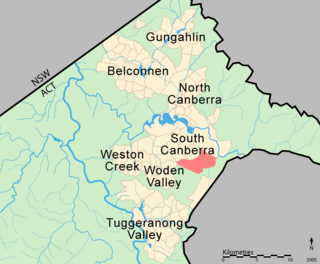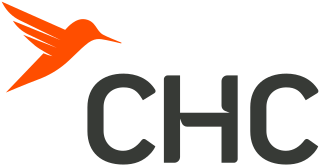| Capital Region Retrieval Service | |
The SouthCare Bell 412 Helicopter | |
| Formation | 1998 |
|---|---|
| Purpose | Search and rescue, patient retrieval |
| Headquarters | Symonston, Australian Capital Territory |
Region served | Australian Capital Territory, Southeastern New South Wales |
CEO | Carol Bennett |
| Website | www.snowyhydrosouthcare.com.au |
Snowy Hydro SouthCare was a rescue and aeromedical helicopter service based in Canberra, Australia from 1998 to 2017.

A helicopter is a type of rotorcraft in which lift and thrust are supplied by rotors. This allows the helicopter to take off and land vertically, to hover, and to fly forward, backward, and laterally. These attributes allow helicopters to be used in congested or isolated areas where fixed-wing aircraft and many forms of VTOL aircraft cannot perform.

Canberra is the capital city of Australia. With a population of 410,301, it is Australia's largest inland city and the eighth-largest city overall. The city is located at the northern end of the Australian Capital Territory (ACT), 280 km (170 mi) south-west of Sydney, and 660 km (410 mi) north-east of Melbourne. A resident of Canberra is known as a Canberran. Although Canberra is the capital and seat of government, many federal government ministries have secondary seats in state capital cities, as do the Governor-General and the Prime Minister.

Australia, officially the Commonwealth of Australia, is a sovereign country comprising the mainland of the Australian continent, the island of Tasmania and numerous smaller islands. It is the largest country in Oceania and the world's sixth-largest country by total area. The neighbouring countries are Papua New Guinea, Indonesia and East Timor to the north; the Solomon Islands and Vanuatu to the north-east; and New Zealand to the south-east. The population of 25 million is highly urbanised and heavily concentrated on the eastern seaboard. Australia's capital is Canberra, and its largest city is Sydney. The country's other major metropolitan areas are Melbourne, Brisbane, Perth and Adelaide.
Contents
The area served covered the Australian Capital Territory, as well as parts of New South Wales including the South Coast, Southern Tablelands, Central West and Riverina regions as far south as the border with Victoria. SouthCare operated a single Bell 412 (VH-NSC) through CHC Helicopters Australia, [1] with medical crews provided by the Capital Region Retrieval Service, a part of the ACT Government Health Directorate. [2] The service was backed by significant funding from Hydro-electric energy company Snowy Hydro. By the time the service ceased, SouthCare had conducted 6,963 missions. [3]

The Australian Capital Territory is a federal territory of Australia, located in the south-east of the country and enclaved within the state of New South Wales. It contains Canberra, the capital city of Australia.

New South Wales is a state on the east coast of Australia. It borders Queensland to the north, Victoria to the south, and South Australia to the west. Its coast borders the Tasman Sea to the east. The Australian Capital Territory is an enclave within the state. New South Wales' state capital is Sydney, which is also Australia's most populous city. In March 2018, the population of New South Wales was over 7.9 million, making it Australia's most populous state. Just under two-thirds of the state's population, 5.1 million, live in the Greater Sydney area. Inhabitants of New South Wales are referred to as New South Welshmen.

The South Coast refers to the narrow coastal belt from Sydney in the north to the border with Victoria in the south in the south-eastern part of the State of New South Wales, Australia. It is bordered to the west by the coastal escarpment of the Southern Tablelands, and is largely covered by a series of national parks, namely Jervis Bay National Park, Eurobodalla National Park, and Ben Boyd National Park. To the east is the coastline of the Pacific Ocean, which is characterised by rolling farmlands, small towns and villages along a rocky coastline, interspersed by numerous beaches and lakes.
Missions flown by the helicopter included primary, or rescue missions where patients are stabilised and transported to major hospitals from accident scenes. Secondary missions involved patient transfers between major and regional hospitals to access urgent specialist treatment. Other missions include search and rescue and aerial firefighting. The aircraft was based at a dedicated facility for emergency services helicopters located in Symonston, adjacent to the Monaro Highway.

Symonston is a primarily industrial and agricultural suburb of Canberra, Australian Capital Territory, Australia. Symonston is named after Sir Josiah Symon a Legislator, Federalist and one of the Founders of the Constitution of Australia.

The Monaro Highway is a highway that is located in Victoria, New South Wales and the Australian Capital Territory, in Australia.
In April 2017, Toll Group commenced operating an Agusta-Westland AW139 from the Canberra SouthCare base as part of the NSW Ambulance's new statewide helicopter retrieval network. [4] [5]

Toll Group, part of Japan Post Holdings, is a transportation and logistics company with operations in road, rail, sea, air and warehousing. It has three principal businesses, Global Forwarding, Global Logistics and Global Express Services, with some 1200 sites in about 50 countries, mostly in Asia and the Pacific.

The AgustaWestland AW139 is a 15-seat medium-sized twin-engined helicopter developed and produced principally by AgustaWestland. It is marketed at several different roles, including VIP/corporate transport, offshore transport, fire fighting, law enforcement, search and rescue, emergency medical service, disaster relief, and maritime patrol. In addition to AgustaWestland's own manufacturing facilities in Italy and the United States, the AW139 is produced in Russia by HeliVert, a joint venture between AgustaWestland and Russian Helicopters.


















